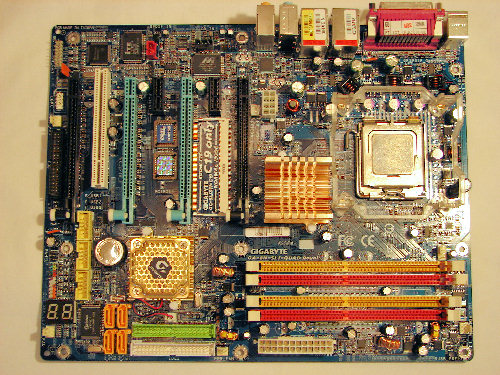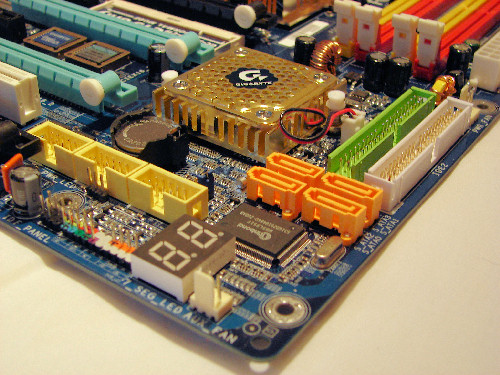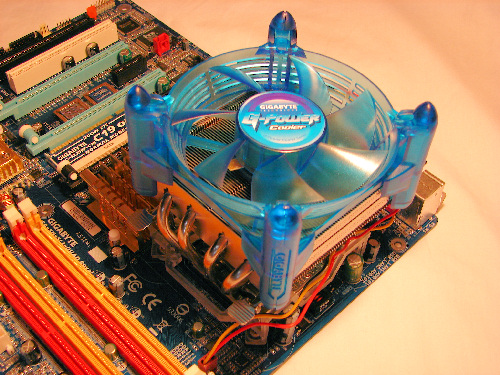Intel Motherboards: Something Wicked This Way Comes...
by Gary Key on October 12, 2005 2:13 PM EST- Posted in
- Motherboards
Gigabyte 8N SLI Quad Royal: Features
Gigabyte did an excellent job with the color coordination of the various peripheral slots and connectors. The DIMM module slots' color coordination is correct for dual channel setup. The power plug placement favors standard ATX case design and the power cable management is very good. Gigabyte actually places the eight-pin 12V auxiliary power connector below the CPU socket area, which should assist in easier installs for newer case designs that mount the power supply at the bottom of the case. In a standard ATX case design, there is the possibility of cable clutter around the CPU socket area with shorter power cables.
The nForce 4 USB connectors are located below the battery and the adaptor connectors are a tight fit when utilizing the PCI slot and bottom PCI Express slot. Also located in this area is a port 80 debug solution based on two-digit LED display.
In between the first two x16 PCI Express slots is a mechanical SLI switch that accepts paddle cards. These paddle cards determine normal or SLI operation along with a special paddle card that activates the Gigabyte dual GPU 3D1 series of video cards. The settings can also be enabled in the BIOS and. throughout testing on the board, we found it best to leave the BIOS setting to Auto and correctly install the appropriate paddle card for fail-safe operation.
The CMOS reset is a traditional jumper design located between the first and second PCI slot that proved to be inconvenient at times.
The Northbridge is passively cooled, but Gigabyte does provide their Cool Plus fan that should be used based on our overclock testing. However, upon installing the fan, it can interfere with a larger style heatsink or a video card in the first PCI Express slot. The Southbridge (CK804 chipset) heatsink is a low profile design with a fan and will not interfere with cards in either x16 PCI Express slot.

Gigabyte did an excellent job with the color coordination of the various peripheral slots and connectors. The DIMM module slots' color coordination is correct for dual channel setup. The power plug placement favors standard ATX case design and the power cable management is very good. Gigabyte actually places the eight-pin 12V auxiliary power connector below the CPU socket area, which should assist in easier installs for newer case designs that mount the power supply at the bottom of the case. In a standard ATX case design, there is the possibility of cable clutter around the CPU socket area with shorter power cables.

The nForce 4 USB connectors are located below the battery and the adaptor connectors are a tight fit when utilizing the PCI slot and bottom PCI Express slot. Also located in this area is a port 80 debug solution based on two-digit LED display.

In between the first two x16 PCI Express slots is a mechanical SLI switch that accepts paddle cards. These paddle cards determine normal or SLI operation along with a special paddle card that activates the Gigabyte dual GPU 3D1 series of video cards. The settings can also be enabled in the BIOS and. throughout testing on the board, we found it best to leave the BIOS setting to Auto and correctly install the appropriate paddle card for fail-safe operation.
The CMOS reset is a traditional jumper design located between the first and second PCI slot that proved to be inconvenient at times.

The Northbridge is passively cooled, but Gigabyte does provide their Cool Plus fan that should be used based on our overclock testing. However, upon installing the fan, it can interfere with a larger style heatsink or a video card in the first PCI Express slot. The Southbridge (CK804 chipset) heatsink is a low profile design with a fan and will not interfere with cards in either x16 PCI Express slot.










44 Comments
View All Comments
SpaceRanger - Wednesday, October 12, 2005 - link
Yup.. Just compared the two, and they are IDENTICAL Pic's, just doctored to show THG and AT... VERY WEAK!!!!!THG:
http://i14.photobucket.com/albums/a342/Arathon/ten...">THG 10 Monitor Image
AT:
http://i14.photobucket.com/albums/a342/Arathon/ten...">AT 10 Monitor Image
johnsonx - Wednesday, October 12, 2005 - link
I doubt one photo or the other was actually doctored, but it is pretty amazing that NOTHING is moved between the two shots... not even the mouse has moved so much as a butt-hair.This does lend credence to the theory that Gigabyte prepared the 10-monitor shots themselves.
at80eighty - Thursday, October 13, 2005 - link
You got issues with butt hair ? :-)
BigLan - Wednesday, October 12, 2005 - link
It looks like this shot was taken at a gigabyte facility, probably in taiwan or china... the blue and red stickers on the monitors look to be chinese characters.vijay333 - Wednesday, October 12, 2005 - link
My guess would be that Gigabyte did this for each one of the sites that it had sent samples to, assuming that they would not be able to set this up themselves (monitors, cards etc). Still, this should have been mentioned in the review itself...Gary Key - Thursday, October 13, 2005 - link
Good Day,I did not want to use the Gigabyte lab shot since THG had already published their version of it. However, since we could not get the revision 2 3D1 cards in time for testing I thought there would be more comments about lack of proof on 10 monitors than issues with the lab shots. I should have noted that in the article.
I was able to get 8 monitors to work with the video setup I had available. However, I found utilizing four monitors was an ideal situation with the two 7800 GTXs. :-)
Bitter - Wednesday, October 12, 2005 - link
Seems a bit....odd, that THG has the exact same picture of the 10 display setup using the exact same displays with associated cables and hardware (and even boxes) in the exact same place...with the sole differance being the background color and logo. Yet THG had their review on 10/4. Yet both sites talk about setting up the system with 10 displays as if they had the gear in house...I smell something rotten here. When you look at the test setups they read almost in stereo. Did either one of these sites actually have the hardware "in the shop" to test any of this out on????johnsonx - Wednesday, October 12, 2005 - link
yeah, as soon as I saw that shot I quickly clicked on "Comments" to see if anyone else had already pointed it out... early bird gets the worm I guess.If I had to guess, I would venture that both THG and AT reviewed the hardware at a common location hosted by Gigabyte.
phaxmohdem - Wednesday, October 12, 2005 - link
Obviously this board is teh suxors since there is no uber AMD variant. What is this now THG?? Pfft.More seriously though, that is kinda cool in its own right. While I wouldn't mind having 4 monitors, 10 seems a bit overkill unless you are an uber l33t day trader or something. I mean wholy crap! Can you imagine the heat that bad boy will put out too? STRONG ass power supply + P4 Dual Core + 4 High End Graphics Cards??? + HDD's + RAM = Heat Stroke in the comfort of your office chair.
Chuckles - Wednesday, October 12, 2005 - link
So...4x$500 for graphics+~$250 for the board+$1000 for the CPU+$200 for RAM.
$3500 for a system. Geez.